
Snow Goose
Chen caerulescens
Anseriforme Order – Anatidae Family
BIOMETRICS :
Length : 66-84 cm
Wingspan : 135-170 cm
Weight : M : 2700g – F : 2500g
LONGEVITY : Up to 25 years
DESCRIPTION:
Snow Goose has white plumage, except black flight feathers.
Fr: Oie des neiges
All : Schneegans
Esp : Ansar Nival
Ital: Oca delle nevi
Nd: Sneeuwgans
Russe: Белый гусь
Sd: Snögås
Photographs by René Lortie
His website: http://rlortie.ca/
Photographs by Bob Moul
His website :
Nature Photography
Text by Nicole Bouglouan
Sources:
GUIDE DES CANARDS, DES OIES ET DES CYGNES – de Steve Madge - Delachaux et Niestlé - ISBN: 2603013769
HANDBOOK OF THE BIRDS OF THE WORLD vol 1 by Josep del Hoyo-Andrew Elliot-Jordi Sargatal - Lynx Edicions - ISBN: 8487334105
Wikipedia (Wikipedia, The Free Encyclopedia)
All About Birds (Cornell Lab of Ornithology)


This species presents two morphs, one white and the other dusk, named blue. In this case, Goose has white head and neck. Lower neck, breast and belly are pale grey. Upperparts and flanks are ash grey-blue. Ventral area, tail coverts and rump are white. Wings are grey with white primaries.
Bill and legs are brownish-pink. Eyes are dark brown.
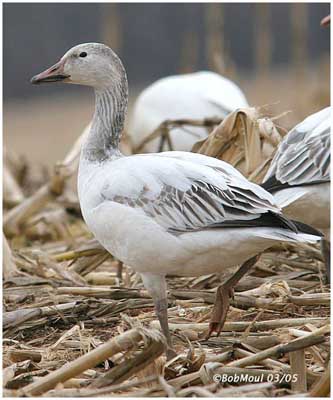
Juvenile white morph has head and neck mottled grey, ash brown back, and brownish secondary feathers.

In blue morph, juvenile has not white on head. Bill and legs are brownish.
Nestlings are olive buff above. Underparts, head and neck are yellow, with olive buff hood on head.
In blue morph, nestlings are grey olive. Bill and legs are grey.
VOICE: SOUNDS BY XENO-CANTO
As all geese, Snow Goose is very noisy. In flight, it constantly utters a strong, nasal high pitched squeak “la-luk” or “uk-uk”, which may resemble distant dog barks.
Alarm call is lower “angk-ak-ak-ak”. Otherwise, it is a soft ascending “koïk”.
HABITAT:
Snow Goose breeds in the tundra, and winters in wet areas, meadows and fields in coastal areas.
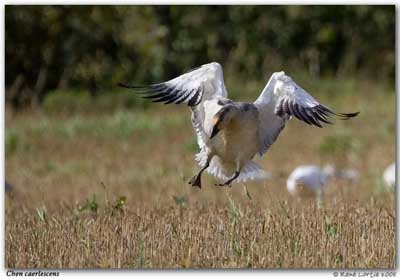
RANGE:
Arctic during summer. In winter, mainly along North America coasts, Gulf coasts, and from Asia to Japan.
BEHAVIOUR:
To feed, Snow Goose grazes vegetation, on the ground or in the water. It feeds in flocks. It is very gregarious, even in breeding season. It nests in colonies of up to several thousands of pairs. It nests sometimes with Brent Geese and Canada Geese.
It migrates in large flocks.
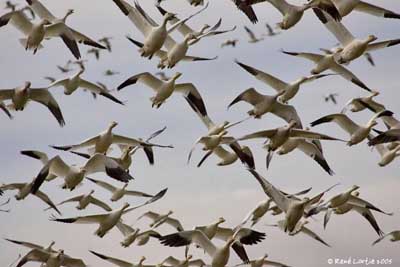
FLIGHT:
A flight of thousands pure white Snow Geese is a wonderful show. When a flock takes off, it looks like a white cloud ascending in the sky. When they are ready to land, they slowly fly down, similar to snowflakes, and black tips of their wings give rhythm to their movements when landing.
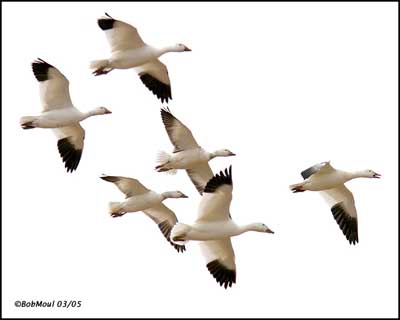
In fall migration, some of them perform flights without any halt of about 3500 km, with speed up to 80 km per hour. Migrating flights are floating V-shaped, at about 900 metres of elevation. They always start in August, a few times after setting sun.
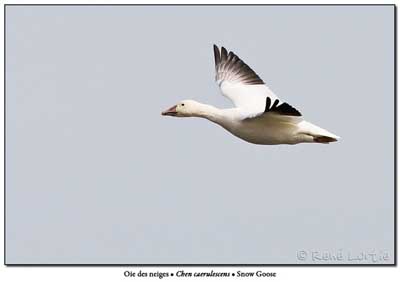
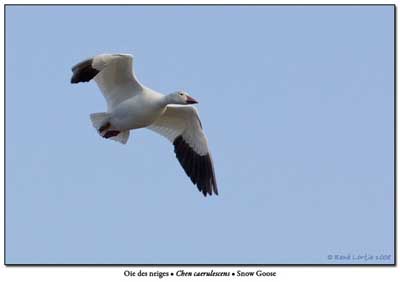
REPRODUCTION:
Breeding season begins in June. Snow Goose nests in colonies. Nest is situated on the ground and is a shallow depression, lined with moss, down and grasses.
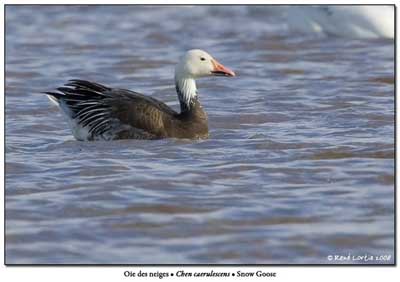
Female lays 4 to 5 creamy white eggs, of 78 x 52 mm of size and 127 gr of weight. Incubation lasts about 22 to 25 days, by female and male surveys the nest site. Chicks hatch synchronized. Nestlings are fed by both parents. They get their complete plumage at about 42 to 50 days. They remain with parents until next breeding season. They reach their sexual maturity at two years of age, but they don’t breed before three or four years.
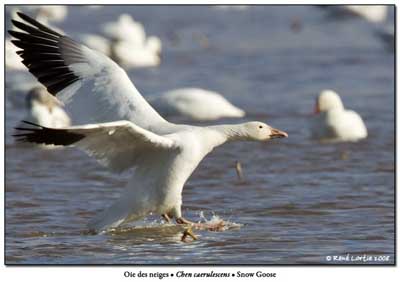
DIET:
Snow Goose is mainly vegetarian. It consumes roots, tubers, leaves, grasses, seeds and stems of aquatic plants, and sedges. During winter, it feeds on grains and vegetables.
Nestlings are mostly fed with mosquitoes.
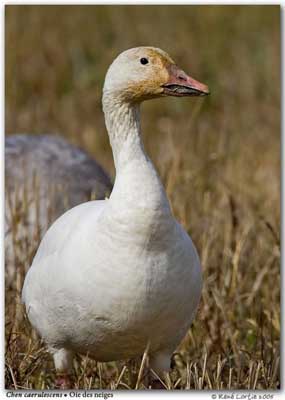
PROTECTION/THREATS/STATUS:
Clutches are threatened by arctic foxes, skuas, gulls, and raptors.
Population is not endangered. Snow Geese are very numerous. They use to feed on cultivated areas where they find abundant food resources after crops.
Snow Goose is common in captivity.